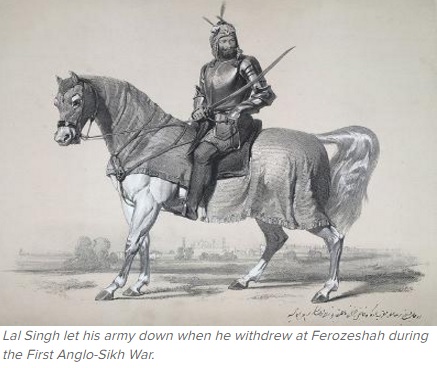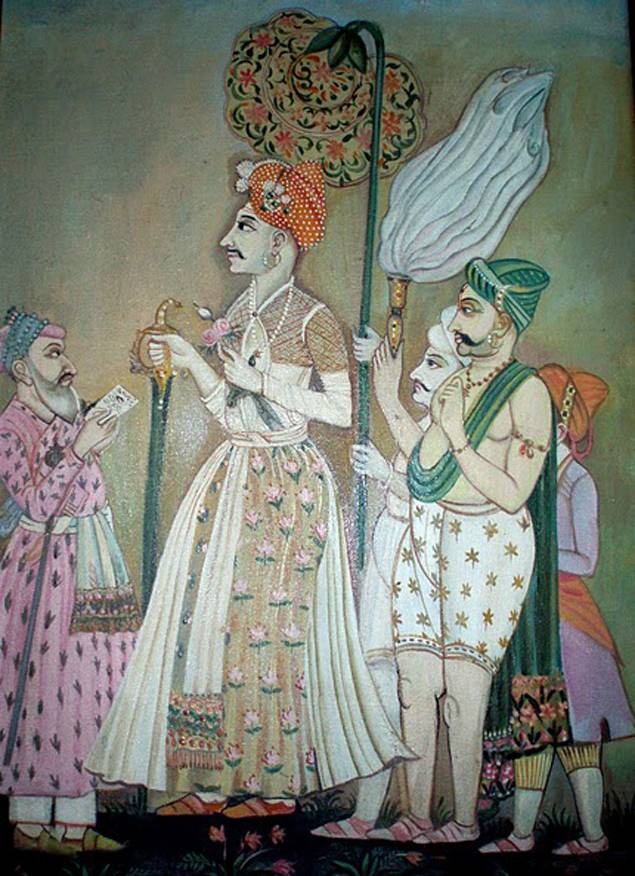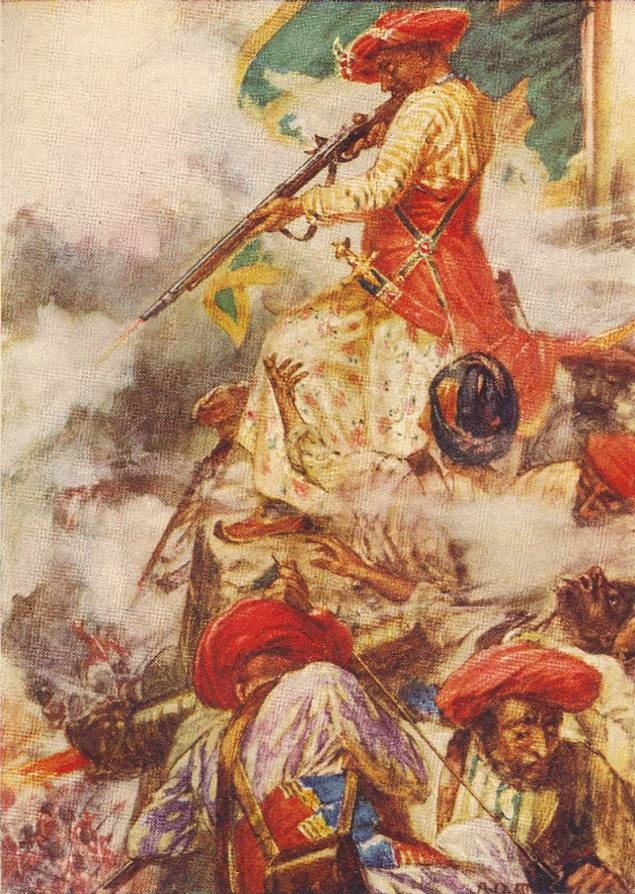Indian Army: History (1761- )
This is a collection of articles archived for the excellence of their content. |
Contents |
Part 1: Panipat to Festubert
Evolution of Indian military: From Panipat to Festubert
The Times of India Manimugdha S Sharma,TNN | Sep 26, 2014

1761: Panipat
Late afternoon on January 14, 1761, Maratha generals and soldiers fleeing the battlefield at Panipat took with them an indelible memory of Ibrahim Khan Gardi's artillery and musketeers wreaking havoc on the enemy "like a knife slicing through butter". Despite their thinning ranks, the French-trained Telangi infantry, who called themselves Gardis in the honour of their illustrious commander, fought like true professionals. Though predominantly Muslim, they stayed loyal to the Brahmin Peshwa and fought a Muslim coalition, ignoring blandishments and threats till the very end. If all Maratha generals had stuck to the original plan drawn up by Ibrahim Khan-that of forming a hollow infantry square and forcing a passage to Delhi by destroying the Afghan right flank-the result of the Third Battle of Panipat could have been different.
But despite the defeat, Panipat made it clear to the Indians that subsequent battles in the subcontinent will be won by the boom of artillery and rattle of musketry. According to Dr Uday S Kulkarni's exhaustive account of the battle titled 'Solstice At Panipat: 14 January 1761', Maratha generals like Scindia, Holkar and Gaekwad, who were staunch critics of Maratha commander-in-chief Sadashivrao Bhau's touching faith in Ibrahim Khan Gardi and his European style of fighting, would change their minds and increasingly repose faith in European-styled drilled infantry and artillery. In fact, they would also abandon their traditional strength of guerrilla warfare or ganimi kava, a process that started right from the Panipat battlefield. But the Marathas weren't alone in this: soon, most Indian rulers were racing one another to modernise their armies. This phase also saw a gradual departure from the mediaeval practice of assigning more weightage to cavalry than any other combat arm.

Nawab Shuja ud-Daulah of Avadh
But it was Nawab Shuja ud-Daulah of Avadh who was among the first to utilise lessons learnt at Panipat. He had allied himself with Ahmed Shah Abdali, but neither he nor his forces took any active part in the battle. In 1764, his moderately Europeanised army led by westerners-including Walter Reinhardt Sombre or 'Samru sahib', the husband of Begum Samru-gave a tough time to the English at Buxar, the first battle fought by the English for territorial control in India. Shuja's army also had Rohillas and Afghan cavalry, who were mostly veterans of Panipat. His artillery directed devastating fire on the British. But the British held out with the wily Hector Munro in command and some disciplined musketry by the infantry, the backbone of which was formed by over 5,000 sepoys. Shuja's forces, with all their bravery, had no answer for the Anglo-Indian bayonet charge.
Despite the defeat, Shuja continued to modernise his army, raising 18 European-styled infantry battalions by the 1770s. But he would never get the chance to measure swords with the English again as Avadh became a vassal state of the English after Buxar.
Buxar
Indian history books today, while recognising Buxar as a watershed moment in our national history, skip another important point: that it was at Buxar that the identity of the Indian sepoy as a match-winner for the British was established (though four years earlier at Plassey, Robert Clive was disappointed with Indian officers and made it a rule that Indian troops will only be officered by Europeans-a condition that stuck on until the end of First World War). And it was at Buxar that the foundation of the Indian Army of today was laid. From that point on, the sepoy would be the backbone of English armies conquering different Indian states one by one. The English would gradually develop a blind faith in the Indian sepoy: a phase that would last until 1857 and continue again towards the end of the 19th century.
For the Marathas, it was Mahadji Scindia who broke new ground in Europeanisation of his army. Scindia employed a brilliant French mercenary, Benoit de Boigne, to raise a brigade that could dress, march and fight as a European army. A former officer in the French, Russian and Honourable East India Company's armies, de Boigne taught Scindia's men the British musket drill and everything else that he knew on the condition that he wouldn't be made to fight the English with whom he had cordial relations. Mahadji's meteoric rise as the dominant power in the north of India hinged on the shoulders of this able Frenchman. Mahadji's new, formidable army came to be known as 'Fauj-i-Hind' or 'Army of Hindustan'. By 1790, it had 37,000 soldiers trained in the European fashion, and 330 pieces of artillery. But after Mahadji's death in 1794, his less capable grandnephew and successor Daulat Rao Scindia would fritter away the gains of his predecessor. He would wage fratricidal wars with other Maratha chieftains and lose both territory and reputation fighting the British. His army stopped attracting talent, both due to his own apathy and some shameless nepotism practised by his French general, Perron. But they would still give Arthur Wellesley, the future Duke of Wellington, his "toughest battle" at Assaye.
Hyder Ali and Tipu Sultan
Elsewhere in the south, Nawab Hyder Ali was raising a formidable army. Hyder was impressed with the British and wanted their military assistance to modernise his army. The British were reluctant, which led Hyder to seek help from the French. With French help, Hyder modernised his infantry and artillery, but unlike other Indian powers of the day that ignored cavalry, Hyder's focus was always on his cavalry and he used it with great skill, always leading it from the front. In fact, the Mysore cavalry, with its dash and daring, had built for itself a fearsome reputation among its rivals. In the 1770s, Hyder Ali had 20,000 cavalry, 20 battalions of infantry and an unknown quantity of guns. Even the English grudgingly admitted Mysore cavalry's superiority, though they referred to its actions as that of a swarm of locusts on crops.
Hyder Ali and Tipu Sultan also abandoned the common Indian practice of engaging militias raised by provincial governors in war time and went for a fully centralised recruiting and training system. A very rudimentary form of regimental system was also followed. But by Tipu Sultan's time, Mysore artillery had attained a high degree of finesse. Tipu introduced a rocket artillery corps organised in kushoons. Tipu's guns were also known for their longer range and accuracy. It's not known how many artillery pieces he had; but at the fall of Srirangapatnam and Tipu's death in 1799, the British found 421 gun carriages, 176 12 pounders and 4,12,000 iron round shots ranging from four to 42 pounds inside the fort.

A few years after Tipu Sultan's collapse, the process of the end of the Maratha Empire began as well. The Peshwa signed the Treaty of Bassein with the English in 1802, agreeing to station a 6,000-strong British force in his territory. The Poona Horse (now 17 Horse, Indian Army) was thus born.
Third Anglo-Maratha War
After the Third Anglo-Maratha War ended in 1818, the Maratha Empire ceased to exist and the Peshwa's army was disbanded. Many former soldiers of the Peshwa found service in the Bombay Army of the HEIC. They were placed in the Poona Horse, Bombay Sappers and Miners and Maratha Light Infantry. Among the first to join these regiments were the Gardis.
Up north, with the decline of the Scindia's power and due to irregularities in pay, many of Scindia's well-trained troops left him and sought greener pastures to the west. They soon found a new employer who was willing to pay them more, both respect and money.
Maharaja Ranjit Singh
He was Maharaja Ranjit Singh, the lion of Punjab.
Ranjit Singh wanted to modernise his army. The visionary ruler knew a clash with the British was inevitable at some point in the future and he wanted to be fully prepared for that. He employed Europeans of different nationalities to train his troops. Ranjit Singh organised his infantry on French lines, cavalry on British as well as traditional lines, and artillery on European lines. The English were so alarmed by this tremendous expansion of force that they ordered the arrest of any Frenchman trying to cross the Sutlej.
Despite the build-up, the clash that Ranjit Singh foresaw didn't happen in his lifetime but after his death and when the Sikh state was in considerable decay.
Just before the First Anglo-Sikh War, the Sikh army had grown bigger than the state could support. According to UK-based military historian Amarpal Singh's book, 'The First Anglo-Sikh War', in 1839, the Lahore state had an army consisting just under 47,000 regular infantry,16,000 regular and irregular cavalry, and 500 pieces of artillery. The artillery was mostly manned by Muslim gunners.

But after Ranjit Singh's death, there was a period of anarchy that saw too many court intrigues and rapid decline in leadership of the army. The army, though, continued to expand (over 80,000 in 1845) and went out of control. It functioned through village panchayats that were subservient to none. The soldiers were paid twice the sum that a sepoy in HEIC's army received every month. The soldiers also resorted to loot and plunder whenever they wanted.
Amarpal Singh argues that the Lahore state engineered a situation whereby the growing influence of this republican Sikh army could be curbed-by crossing the Sutlej and inviting an English attack in 1845.
All through the war, the Sikh commanders abandoned the field, leaving their men to fend for themselves, at early stages of battles. At Ferozeshah, for instance, the Sikhs had clearly dominated the battlefield with their artillery completely destroying the British artillery, and infantry returning fire with amazing rapidity. Sitaram, a sepoy in the British army, as quoted by Singh in his book, pretty much summed up the ground reality when he wrote: "Volleys of musketry were delivered by us at close quarters, and were returned just as steadily by the enemy. In all the previous actions in which I had taken part one or two volleys at short range were as much as the Sirkar's (the British state's) enemies could stand; but these Sikhs gave volley for volley, and never gave way until nearly decimated..."
Yet, instead of moving forward and decimating the enemy, the commander, Lal Singh, ordered a general retreat, much to the chagrin of his own troops. The Sikhs abandoned all their guns and equipment and left.
(To be continued)
(Write to this correspondent at manimugdha.sharma@timesgroup.com)
Pay and perquisites during British Raj
The Times of India, Jul 06 2015
Manimugdha Sharma
Were Army pay and perks better under the British?
At Delhi's Jantar Man tar, armed forces veter ans have been sitting on a relay hunger strike since June 15 to protest against the Modi government's flip-flops on the implementation of OROP (One Rank, One Pension) scheme. “Is this a government of our people? Even the British treated us better,“ a war veteran mutters.
So, did the Raj really treat Indian soldiers better? The Indian Army sepoy was never really paid well at any point in history . After the Mughals, the East India Company became the best paymaster in the subcontinent, and the prospect of regular pay attracted talent from all corners of the country . It was perhaps rivalled only by the Sikh Empire after Maharaja Ranjit Singh's death and that too for a short time (the Khalsa Army's pay was double the Company salaries).
“The Army got a better deal during the Raj. Western societies look up to the Army as an institution that upholds the nation state. It's still customary in the US for people to say `thank you' to a war veteran; in the UK, they make way for war heroes, and a Victoria Cross winner always meets with a standing ovation wherever he goes. In India, the colonial state accorded privileges to the Army because it was essential for British rule,“ says military historian Squadron Leader Rana Chhina (Retd) of USI-CAFHR. Dr Gajendra Singh, who teaches South Asian history at the University of Exeter, says the monthly pay of a sepoy was fixed at Rs 7 in 1860, Rs 9 in 1895 and Rs 11 in 1911. But the money was often lower than the cost of subsistence which was estimated in 1875 at Rs 7, two annas and five paise.
Indian officers in the 1860s and thereafter were, of course, better off. A risaldar major in the cavalry was paid Rs 150, a risaldar Rs 80, and a jemadar Rs 50 a month. But even these were extraordinarily low when compared to what the European officers received: cavalry or horse artillery colonels, for instance, were paid Rs 1,478 per month, lieutenant colonels, Rs 1,032 and majors, Rs 929. By today's standards, the colonel was being paid the equivalent of around Rs 8 lakh then (as per the National Archives, UK, old currency converter, Rs 1,478 is approximately 280 pounds per day , which is around Rs 8 lakh per month).
Worried that the Raj wouldn't attract top talent, se poy salaries were upped in the latter half of the 19th century .
About 40% of the Indian Ar my in peacetime was allowed to go on furlough to till their lands. “ Also, extraordinary payments like batta were fixed at an extra Rs 5 by 1914 and British officers were en couraged to shower gifts on their men. Military service by the 1890s in Punjab was seen as a way of getting a land grant upon discharge, of em ployment in other forms of co lonial service, or of enabling migration abroad -up to 50% of early Punjabi migrants to Canada and California in 1901-1911 were pensioned sol diers,“ Dr Singh says.
The pensions varied across ranks and number of years spent in service and was , in the range of 50%-70% of sal aries (until 1973, officers were paid 50% and sepoys, 70% of f their salary as pension. Today , it is 50% across ranks.) While the salaries and perks were good, the men were treated, says Dr Singh quoting Kipling, as `half-devil and half child' -in need of a nurturing hand and back-of-the-hand discipline. “Flogging re, mained a summary puni, shment until 1921, about 60 years after it disappeared from the British Army,“ he says. When India became inde pendent, Raj-era privileges were systematically taken , away from the armed forces.
A mercenary tradition converted into a nationalist tradition in August, 1947
I am revealing no secret when I say that what had been a mercenary army on August 14, 1947 renamed itself a nationalist army the next morning. We have no history before that of a nationalist army, unlike, say, Turkey .
The mercenary tradition of the Indian armed forces goes back at least 2,500 years. The first Greek historian Herodotus describes Indians at the battle of Plataea in 479 BC hired by the Persian emperor Xerxes (the Indians acquitted themselves well, though the battle was lost to the Greek alliance).
Ghalib, who died in 1869, said famously: “Sau pusht se, hai pesha-e-aba sipahgari“ (for a hundred generations, our family profession has been soldiery).The world has long respected the Indian soldier's abilities. It is he who taught the European trench fighting in what they call their Great War.
Alexander the Great's fawning biographers, Arrian, Quintus Curtius Rufus and Plutarch, say only one action stained the conqueror's record. He concluded a treaty with a group of Indian mercenaries and then treacherously had them murdered after they disarmed. He did so because he respected and was threatened by their fighting ability .
Every day, on my way to work, I go past the headquarters of the Madras Sappers in Bengaluru. A tank in desert camouflage is at the gate, its cannon overlooking the pretty Ulsoor Lake. I'd like to row on it but civilians are forbidden. On the lake are little rock islands on the walls of which are painted the names of great Sappers victories, like Assaye Ganj.
Who was defeated at Assaye? The Marathas. Who were the Sappers fighting for? Arthur Wellesley, later to become Duke Wellington (of Waterloo fame).The Sappers HQ gate proudly announces the year the unit was formed: 1780, more than a century and a half before Independence. Who did the Sappers shoot and bayonet and mine and blow up all these years? Other Indians.
Colonel Dyer only gave the order in 1919 at Jallianwala Bagh. Aim was taken and triggers pulled by the Gurkha Rifles, and by the Punjabis of Baloch Regiment (the Baloch did not and do not have a tradition of soldiery).
This country sleeps because its soldiers are awake, in the words of the Prime Minister. Such sentiment is accepted unquestioningly . It is because of this sentiment that a nation that spends Rs 33,000 crore on the health of its citizens paid Rs 59,000 crore for 36 warplanes this year. There was some criticism of this government because it actually cut the health budget.
See also
and many more...